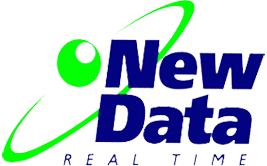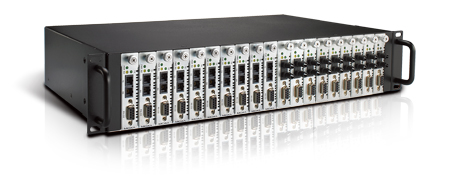- 19-inch chassis for rackmount use
- 19 slots for high density applications
- Supports hot-swap and dual power input with redundancy
- Fanless chassis design reduces servicing costs
The TRC-190 series provides 19 slots for media converter modules from the CSM-200 series of Ethernet-to-fiber modules and the TCF-142-RM series of serial-to-fiber modules. A TRC-190 chassis comes with one AC or DC power input, with an optional redundant power expansion module available for greater reliability. The TRC-190 series’ power input module supports the hot-swap feature.
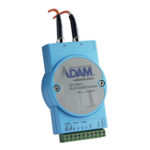

The ICF-1150 series support 2 serial ports, with a DB9 connector for RS-232 communication and a removable terminal block for RS-422 or RS-485 communication. The 3 ports (2 serial ports and one fiber port) are completely independent. When an ICF-1150 converter receives data from any one port, it will send the data out through the other 2 ports. For example, once the ICF-1150 converter receives a command from the remote master through the fiber port, it will convert the signal and send the command through the RS-232 and RS-422/485 ports at the same time. If the user is monitoring a system running on an RS-485 network, there is no need to use an additional RS-232 to RS-485 converter to connect the laptop computer’s serial port to the RS-485 bus.
The RS-485 interface supports multi-drop or daisy-chain connections, which system engineers will use to connect serial devices such as meters, RTUs, and readers, together on the same bus. Since the number of serial devices on the same bus will cause the impedance of the data line to increase, the ICF-1150 allows users to tune the pull high/low resistor. Just rotate the switch to the appropriate value without removing the ICF-1150 from the DIN rail.
.png)

The TCF-90 is a compact media converter that transmits RS-232 signals over optical fiber. Power is derived from either the serial port or an external power source. The TCF-90 extends RS-232 transmission up to 5 km with multi-mode fiber, or up to 40 km with single-mode fiber. A pair of TCF-90 converters can be used to connect two RS-232 devices with optical fiber in full duplex mode. The optical fiber isolates the data signals from dangerous increases in ground potential, ground loops, and electrical EMI/RFI noise, and enhances data security by eliminating the harmful effects of RF radiation and susceptibility to electromagnetic radiation.
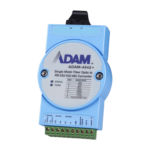
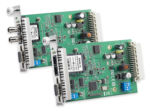
The TCF-142-RM series of serial-to-fiber converters are slide-in modules that work with the TRC-190 chassis. The modules convert from the RS-232, RS-422, or RS-485 signal to a fiber optic signal.
The TCF-142-RM series can automatically detect the serial baudrate. This is an extremely convenient feature. Even if a device’s baudrate is changed, the signal will still be transmitted through the media converter without any problem.

The TCF-142 media converters are equipped with a multiple interface circuit that can handle RS-232 or RS-422/485 serial interfaces and multi-mode or single-mode fiber. TCF-142 converters are used to extend serial transmission up to 5 km (TCF-142-M with multi-mode fiber) or up to 40 km (TCF-142-S with single-mode fiber). The TCF-142 converters can be configured to convert either RS-232 signals, or RS-422/485 signals, but not both at the same time.
The TCF-142 converters can automatically detect the serial baudrate. This is an extremely convenient feature. Even if a device’s baudrate is changed, the signal will still be transmitted through the media converter without any data loss.

The TCF-142 converters can be used to connect serial devices to a fiber ring. To form the ring, connect the Tx port of one TCF-142 to the Rx port of a neighboring converter. Once the ring is set up, simply use the DIP switches to configure the TCF-142 converters for “ring mode.” When one node transmits a signal, the signal travels around the ring until it returns back to the transmitting unit, which then blocks the signal. With the TCF-142, you can set up fiber rings that have a total circumference of up to 100 km.
ADDC® is a patented hardware data flow solution developed by Moxa to handle RS-485 data direction control. ADDC® senses and controls RS-485 data direction automatically, making it unnecessary to use the hand shaking signal.
Esta web utiliza cookies propias y de terceros para analizar su navegación y ofrecerle un servicio más personalizado acorde a sus intereses. Continuar navegando implica la aceptación de nuestra Política de Cookies.
ACEPTAR



